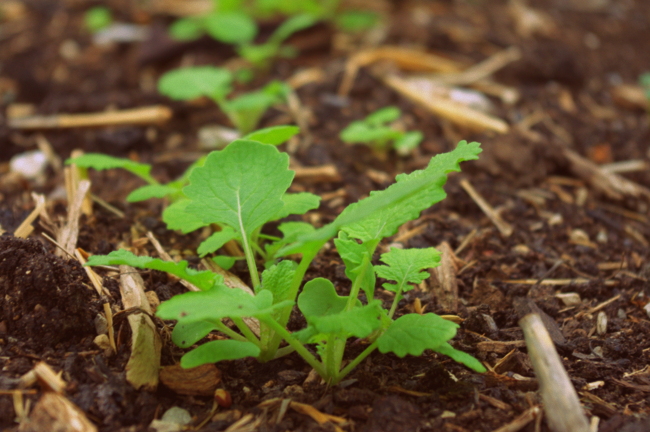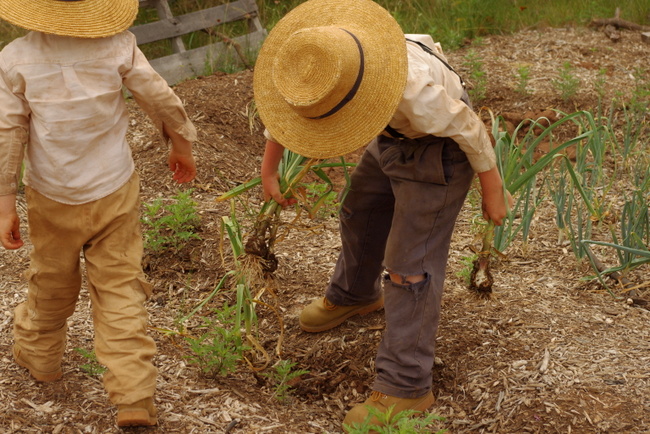A Garden Tour in July
When I posted some soundbites from the garden, I realized that I haven’t fully shared here a broader look at the gardens. We have three main garden areas – the chicken field, the pallet garden, and this year’s new addition of the (how have I not told you about this?!) food forest.
This little man has a passion for all things propagation and plant, so I thought I’d let him show us around. Care to join us?
The Chicken Field

When you leave our little cabin, you wander down a path past the rain water catchment tank and on your left is our first garden area. This is the homemade gate to the chicken field, so called because of its proximity to what was our first chicken coop. That coop has since been turned into a compost heap (quite literally), and we are now on our third iteration of chicken housing.
I put our tour guide, Abram, in chard of planting sunflowers along the east fence line, and plant he did. You are immediately greeted with these beauties upon entering.
The chicken field started neat and tidy this spring with four long rows of beans. Those got eaten up about three weeks after the boys and I planted them, so we started over. A row of melons now bookends slightly haphazard plantings of black eyed peas, pigeon peas, as pictured above, and volunteer sweet potatoes. Stewart also threw out some sod buster radish seeds, which have been really exciting and I need to tell y’all about them sometime.
Last year this space looked neat and tidy. This year, we’ve let the weeds take over a bit. Honestly, though, I think the weeds are actually helping with shade and additional ground cover on these hot days, so I’m in no rush to pull them all.
This just in… there are 16 melons in the chicken field! (I wish I could convey the enthusiasm with which that was reported by our oldest boy.)
The Pallet Garden
If you wander a bit beyond the chicken field and hook a right before you get to the bright red chicken coop we use today, you will reach the pallet garden. Don’t worry, though, it’s kind of hard to miss.
Have I mentioned how much I enjoy all things homemade, including gates?
If you come in here with the children, the first thing you’ll hear is little Annabelle whispering “‘mater, ‘mater, ‘mater” as she waits for the gate to open. Then all bets are off as they all dart to the three tomato trees plants to the right. Tomatoes were just a little afterthought in the garden this year as low maintenance calorie crops like beans, roots, and greens took center stage.
Those tomatoes are shaded by pallets and surrounded on three sides by patches of black eyed peas. When you first walk in you’ll want to watch your step as the tatume summer squash nestled within those black eyed peas is sprawling. The six other summer squash plants just don’t seem to feel the need to stretch out as that one does.
Looking straight ahead from the gate you’ll see more black eyed peas (they never disappoint) along with a row of Lucullus Swiss Chard, also shaded on one end with pallets, and the last beet that I’ve been meaning to pull but just can’t quite bring myself to do.
To the left is, big surprise, more beans and tons of weeds. Again, I’m only pulling weeds as necessary to encourage shade and ground cover. If you look past the black trash can that holds water pumped via solar power from our ponds, you’ll find a small sea of spearmint, peppermint, and orange mint. Also back there are a handful of tomato plants we recently put in as well as a volunteer squash.
And finally, looking to your left as you just enter the garden, there is a row of okra, another couple of rows of beans, and the medicinal herb area. Here we have mullein, tulsi, and wild oregano. There are also chives throughout the garden. And, just beyond that pallet, is the strawberry patch. So far the boys have each planted two strawberry plants, but I’m pretty sure they’re looking to expand that operation.
And that’s the pallet garden.
When you leave the pallet garden you will wander back to that bright red chicken coop and take a right. Here, Stewart dug some swales as we began getting heavier spring rains. On top of these swales we planted black eyed peas and blue speckled beans. Yep, there are a lot of beans.
We have chosen to fence the chickens out of garden areas rather than fencing them in. It helps with grasshopper control and seems to work for us. I’ve been surprised that this unfenced area of beans has gone rather unscathed thus far.
And finally, the furthest 1/8-1/4 acre of our little two acres is the food forest. This homemade gate leads us to more swales planted in sunn hemp, black eyed peas, and blue speckled beans. Not pictured is a host of different fruit trees, berry bushes, perennial herbs, sweet potatoes, flowers, and other lovely things.
But maybe Abram can show us more of that on another day.















Oh it all looks so lovely! With the summer heat in Texas, we also choose to let the weeds grow in the garden and act like a cover. They seem to keep moisture in, and keep the soil from getting blazing hot. It’s not nearly as pretty, but it does work! May you have a blessed harvest.
I do so enjoy reading your blog. Such a lovely post. And what a cute little helper. I love his name you chose.
It’s enjoyable seeing what you are doing and the wonderful garden you all have produced. It’s inspiring and encouraging and we chip away ourselves at doing something a bit similar, but way up in cold MN! 🙂 I know you are familiar with the temps up here. 🙂 Hey, though at least we are now averaging 73 degrees!
Where did you guys find all of your pallets? Did you have to buy them? Everyone up here seems to want a decent chunk of change for them.
Therese – Our pallets were all obtained free from our local small town hardware store. I can’t imagine paying for them, though, so I doubt we would make such use of them if we did. Maybe there is another free resource in your area?
Love hearing about Minnesota. 🙂
I’m envious because we’re in the depths of winter here. The other option you have with weeds is to ‘chop and drop’ them for mulch to cover the soil around plant roots. This would help delay or prevent them from seeding but still provide ground cover/shade/moisture preservation/nutrients for the productive plants. I do it with a kama (curved knife), a bit like a sickle but smaller.
Thank you for sharing your wonderful and exciting adventure of ‘life’ in the garden.
Just wanted to share something really quickly regarding composting. What I have found as very rewarding and truly a blessing is this. I compost straight into my garden. I’ll garden around it, but not on it until the next season. I’m always rotating my compost through my garden areas. It truly works excellent! I wouldn’t do it any other way. All the proper break down happens….and the heat it puts off…allows the plants near by to do beautifully when all other gardens in our town fail when they plant when I do. The lists go on and on. Hope that was a help to someone whom is overwhelmed with composting.
Blessings,
Wendy
Hy my name is Kent. Did I remember right that you all moved to texas frome the UP of michigan? My family live in central upper michigan. I grow a large garden and am planing to expand by at least 3 times. I’m presantly using 3 american guinea hogs to clear the land. I also have laying hens and cornish cross. We also have red new zealand rabbits. I had double breasted turkeys last year. This year I plan to invest in some heritage turkeys. Probably Narragansett. They are a little messy but I like having them around. I also have a chance to get some bourbon red eggs. Producing my own food that I can see grow is my thing.Hope to talk to you again.
Hi Kent,
We moved from downstate Michigan to Texas but spent time in the UP before that. It sounds like you’ve got quite the collection of animals up there. American Guinea Hogs and Cornish Cross are both on the list of animals we are wanting to look into. Do you have any advice or recommendations for where we can source these animals or get more information?
All the best to you in your endeavors,
Shannon